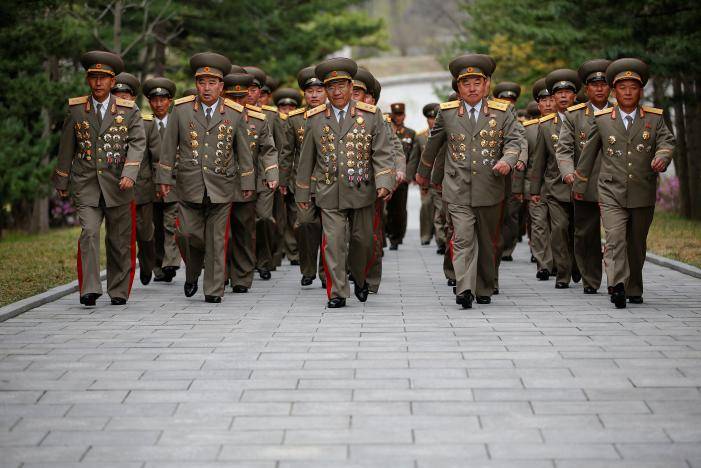Seoul (Reuters): Appeared to be new long-range and submarine-based missiles displayed by North Korea on the 105th birth anniversary of its founding father, Kim II Sung today (Saturday), as a nuclear-powered U.S. aircraft carrier group steamed towards the region.
A U.S. Navy attack on a Syrian airfield this month raised questions about U.S. President Donald Trump's plans for reclusive North Korea, which has conducted several missile and nuclear tests in defiance of U.N. and unilateral sanctions, regularly threatening to destroy the United States.
North Korean leader Kim Jong Un, Kim Il Sung's grandson, looking relaxed in a dark suit and laughing with aides, oversaw the huge parade on the "Day of the Sun" at Pyongyang's main Kim Il Sung Square.
Goose-stepping soldiers and marching bands filled the square, next to the Taedonggang River that flows through Pyongyang, in the hazy spring sunshine, followed by tanks, multiple launch rocket systems and other weapons.
Single-engine propeller-powered planes flew in a 105 formation overhead.
Unlike at some previous parades attended by Kim, there did not appear to be any a senior Chinese official in attendance. China is North Korea's lone major ally but has spoken out against North Korea's missile and nuclear tests and supported U.N. sanctions.
The North has said it has developed and would launch a missile that can strike the mainland United States but officials and experts believe it is some time away from mastering all the necessary technology.
Weapons analysts said they believed some of the missiles on display were new types of intercontinental ballistic missiles (ICBM).
North Korea showed two new kinds of ICBM enclosed in canister launchers mounted on the back of trucks, suggesting Pyongyang was working towards a "new concept" of ICBM, said Melissa Hanham, a senior research associate at the U.S.-based Middlebury Institute of International Studies at Monterey, California.
"However, North Korea has a habit of showing off new concepts in parades before they ever test or launch them," Hanham said.
"It is still early days for these missile designs".
North Korea, still technically at war with the South after their 1950-53 conflict ended in a truce but not a treaty, has on occasion conducted missile or nuclear tests to coincide with big political events and often threatens the United States, South Korea and Japan.
It warned the United States that any provocation would be met with retaliation.
"All the brigandish provocative moves of the U.S. in the political, economic and military fields pursuant to its hostile policy toward the DPRK will thoroughly be foiled through the toughest counteraction of the army and people of the DPRK," the North's KCNA state news agency said, citing a spokesman for the General Staff of the Korean People's Army.
DPRK stands for the official name of North Korea, the Democratic People's Republic of Korea.
"Our toughest counteraction against the U.S. and its vassal forces will be taken in such a merciless manner as not to allow the aggressors to survive."
KCNA said the Trump administration's "serious military hysteria" had reached a "dangerous phase which can no longer be overlooked".
The United States has warned that a policy of "strategic patience" with North Korea is over. U.S. Vice President Mike Pence travels to South Korea on Sunday on a long-planned 10-day trip to Asia.
North Korea's Pukkuksong submarine-launched ballistic missiles (SLBM) were also on parade. It was the first time North Korea had shown the missiles, which have a range of more than 1,000 km (600 miles), at a military parade.
Displaying more than one of the missiles indicates North Korea is progressing with its plan to base a missile on a submarine, which are hard to detect, said Joshua Pollack, editor of the Washington-based Nonproliferation Review.
"It suggests a commitment to this program," said Pollack. "Multiple SLBMs seems like a declaration of intent to advance the program".
Choe Ryong Hae, a close aide to Kim, addressed the packed square and reiterated the warning to the United States.
"If the United States wages reckless provocation against us, our revolutionary power will instantly counter with annihilating strike, and we will respond to full-out war with full-out war and to nuclear war with our style of nuclear strike warfare," he said.
China, North Korea's sole major ally and neighbor which nevertheless opposes its weapons program, on Friday again called for talks to defuse the crisis.
China banned all imports of North Korean coal on Feb. 26 under U.N. sanctions, cutting off the North's most important export product.
China's national airline, Air China, weeks ago canceled some flights to Pyongyang due to poor demand but it has not suspended all flights there, it said on Friday, denying a report by Chinese state broadcaster CCTV that all flights run by the airline between the two cities were to be suspended.
North Korea on Friday denounced the United States for bringing "huge nuclear strategic assets" to the region as the USS Carl Vinson strike group with a flag-ship nuclear-powered aircraft carrier steamed closer.


